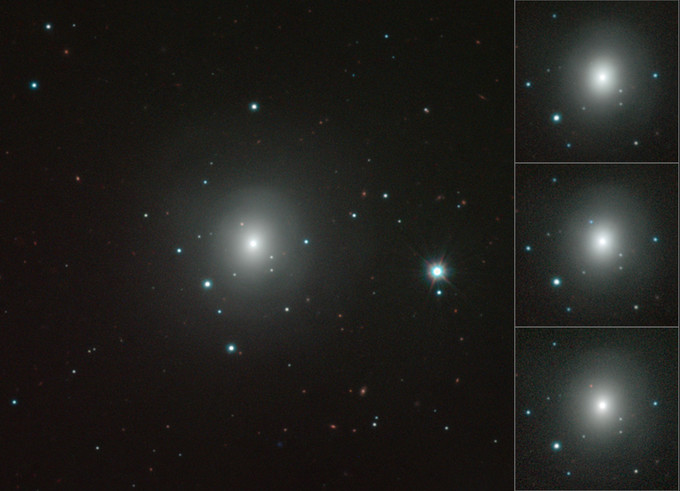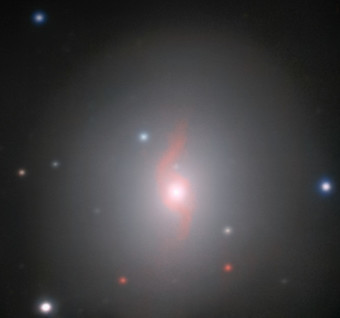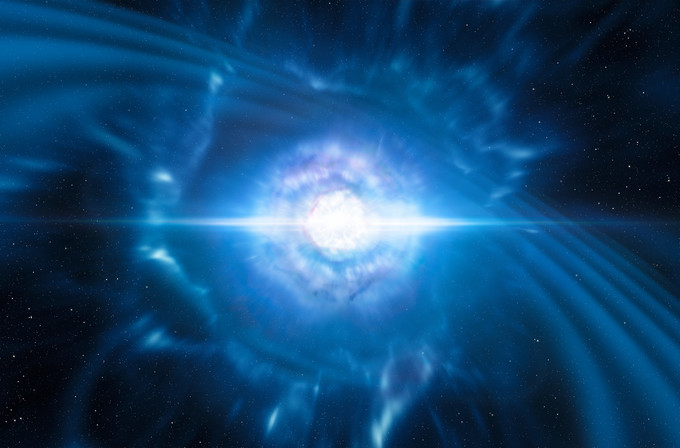GW170817: Breakthrough in multi-messenger astronomy
Munich physicists observe gamma-ray and optical counterparts of the gravitational wave signal
2017-10-16 – News from the Physics Department
The collision of the two neutron stars occurred in the galaxy NGC4993, about 130 million light years away from Earth. The gravitational waves of this massive event were observed by the U.S. Laser Interferometer Gravitational Wave Observatory (LIGO) and its European sister observatory Virgo, on August 17, 2017 (GW170817).
Neutron stars: matter existing under the most extreme conditions
These new observations bring us a step closer to answering a very fundamental question in physics: What is the state of matter in a neutron star? Of all the star types known to science, neutron stars are the smallest and most dense stars. They’re the final stage in the collapse of a massive star and typically have a radius of 10 to 20 kilometers, with about twice the mass of our own sun. According to models, they consist almost entirely of neutrons – because of the enormous density, the electrons of the atomic shells were squeezed into the atomic nuclei converting the protons into neutrons.
Strong nuclear forces preventing a further collapse
A further collapse of the matter in neutron stars is prevented by strong nuclear forces between their neutrons. “Until now, we knew close to nothing about the precise composition and the particle interactions of matter under such extreme conditions,” says Prof. Laura Fabbietti, TUM Professor for Dense and Strange Hadronic Matter and principal investigator of the CRC1258. Fabbietti has been doing research in this field for years. “Now we can test and prove our theories for the first time.”
A short gamma ray burst
The gravitational wave event was accompanied by a short gamma ray burst (GRB170817A), which lasted less than two seconds and was measured by the two detectors – the Fermi-GBM and the spectrometer mounted on the INTEGRAL space telescope – both built at the Max Planck Institute for Extraterrestrial Physics (MPE). “For more than 30 years, the merger of two neutron stars has been suspected to be the cause of such a characteristic short gamma ray burst”, says Dr. Jochen Greiner from the MPE, one of the principle investigators of the CRC1258. “Now, for the first time, we have a clear confirmation for the model.”

The afterglow of a kilonova
The physicists also expected to observe an afterglow in the optical/near infrared light part of the spectrum lasting for days, which is known as a kilonova. Matter – especially neutrons and, in small numbers, protons and helium nuclei – is ejected in all directions following the merger. Within a few seconds, the helium nuclei are converted into heavy elements with high atomic numbers by fusion, further neutron capture and subsequent radioactive decay and nuclear fission.

Radioactive nuclei decay
The newly formed radioactive nuclei subsequently decay into stable elements and emit gamma radiation for up to 10 days, which in turn heats the ejected material and results in a broadband electromagnetic emission. This kilonova was also detected by several teams of astronomers working independently of one another over the course of 12 hours in the approximately 100 square-degree error box of the gravitational wave event.
Confirmation of the theories of the formation of the heaviest elements
“These observations confirm the theoretical models about the merger of neutron stars and their energetic processes, such as the ejection of a considerable amount of radioactive material,” notes Greiner. “Above all, they provide new insights into the astrophysical source of the formation of the heaviest of all elements,” adds Prof. Hans-Thomas Janka from the Max Planck Institute for Astrophysics, principal investigator with the CRC1258, and renowned expert for the modelling of neutron star mergers, supernovae and gamma ray bursts.
No significant neutrino signals detected
Neutrinos could be another kind of “cosmic witness” providing evidence of such high-energy cosmic events like neutron star collisions. However, researchers with the IceCube Collaboration, which operate the world’s largest neutrino telescope at the South Pole, did not detect any significant signals. The explanation is simple: “The event occurred too far away,” explains Elisa Resconi, Professor for Experimental Physics with Cosmic Particles at TUM and spokesperson for the CRC1258 team. “Neutrinos are very elusive particles. At such a distance it is almost impossible to trace the neutrino messengers with our detector. But we’re hoping that IceCube will have the chance to catch neutrino signals from events in the future.”
It’s just the beginning of what astronomy can learn from gravitational waves
Since last year, several gravitational wave signals of merging black holes have been measured – work which was honored with the Nobel Prize for Physics in 2017. The most recent findings on the neutron star event mark another decisive breakthrough in multi-messenger astronomy. “By using gravitational waves, a multitude of new measurements which are complementary to classical astronomy are now possible, and thus the answers to previously unanswered questions are within reach,” Resconi says. This will have a decisive influence on research at the CRC1258 in Munich.
Publications
- Search for High-Energy Neutrinos from Binary Neutron Star Merger GW170817 with Antares, IceCube and the Pierre Auger ObservatoryAntares, IceCube, Pierre Auger, LIGO Scientific and Virgo Collaborationssubmitted to The Astrophysical Journal
- A kilonova as the electromagnetic counterpart to a gravitational wave sourceS.J. Smartt et al.DOI: 10.1038/nature24303
Contact
- Prof. Dr. Laura FabbiettiTechnical University of MunichCRC1258 Neutrinos and Dark Matter in Astro- and Particle PhysicsPhysics DepartmentJames-Franck-Straße85748 Garching, GermanyT: +49 89 289 12433
- PD Dr. Jochen GreinerMax Planck Institute for Extraterrestrial PhysicsGießenbachstraße 185748 Garching, GermanyT: + 49 89 30000-3847E-Mail: jcg@mpe.mpg.de
- Prof. Hans-Thomas JankaMax Planck Institute for AstrophysicsKarl-Schwarzschild-Straße 185748 Garching, GermanyT: +49 89 30000-2228
- Prof. Elisa ResconiTechnical University of MunichCRC1258 Neutrinos and Dark Matter in Astro- and Particle PhysicsPhysics DepartmentJames-Franck-Straße85748 Garching, GermanyT: +49 89 289 12422
